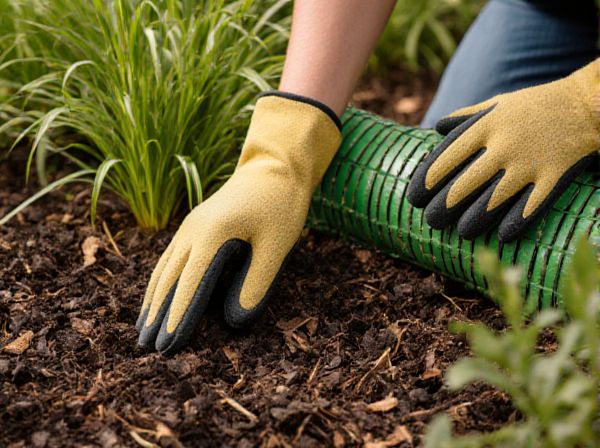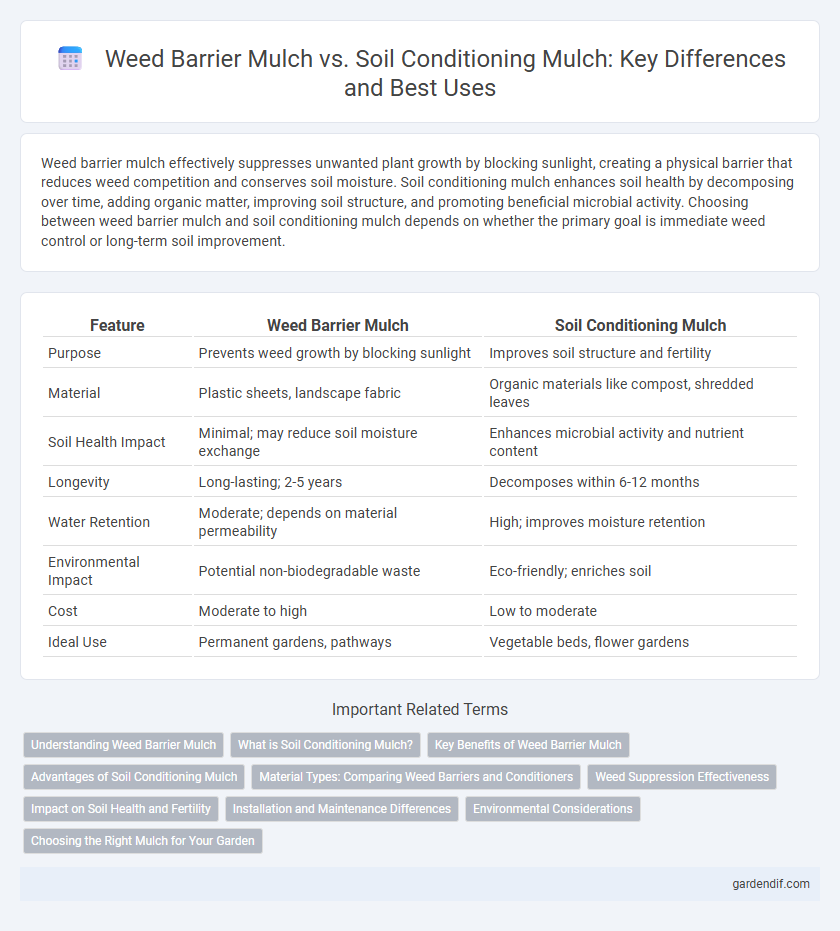
Weed barrier mulch vs Soil conditioning mulch Illustration
Weed barrier mulch effectively suppresses unwanted plant growth by blocking sunlight, creating a physical barrier that reduces weed competition and conserves soil moisture. Soil conditioning mulch enhances soil health by decomposing over time, adding organic matter, improving soil structure, and promoting beneficial microbial activity. Choosing between weed barrier mulch and soil conditioning mulch depends on whether the primary goal is immediate weed control or long-term soil improvement.
Table of Comparison
| Feature | Weed Barrier Mulch | Soil Conditioning Mulch |
|---|---|---|
| Purpose | Prevents weed growth by blocking sunlight | Improves soil structure and fertility |
| Material | Plastic sheets, landscape fabric | Organic materials like compost, shredded leaves |
| Soil Health Impact | Minimal; may reduce soil moisture exchange | Enhances microbial activity and nutrient content |
| Longevity | Long-lasting; 2-5 years | Decomposes within 6-12 months |
| Water Retention | Moderate; depends on material permeability | High; improves moisture retention |
| Environmental Impact | Potential non-biodegradable waste | Eco-friendly; enriches soil |
| Cost | Moderate to high | Low to moderate |
| Ideal Use | Permanent gardens, pathways | Vegetable beds, flower gardens |
Understanding Weed Barrier Mulch
Weed barrier mulch consists of synthetic or natural fabrics designed to block sunlight, effectively preventing weed growth while allowing water and air to penetrate the soil. This type of mulch is essential for maintaining cleaner garden beds by minimizing weed competition without frequent manual removal. In contrast, soil conditioning mulch primarily improves soil structure and fertility through the gradual decomposition of organic materials.
What is Soil Conditioning Mulch?
Soil conditioning mulch is an organic material applied to the soil surface that improves soil structure, moisture retention, and nutrient content by slowly decomposing and enriching the soil. Unlike weed barrier mulch, which primarily suppresses weed growth and blocks sunlight, soil conditioning mulch actively enhances soil health and promotes plant root development. Common examples include compost, shredded leaves, and aged bark, which help maintain soil temperature and support beneficial microbial activity.
Key Benefits of Weed Barrier Mulch
Weed barrier mulch effectively suppresses unwanted plant growth by blocking sunlight, reducing the need for herbicides and manual weeding. It conserves soil moisture and prevents erosion, helping maintain stable soil temperatures and promoting healthy plant roots. This mulch type creates a cleaner garden appearance while minimizing competition for nutrients between weeds and desirable plants.
Advantages of Soil Conditioning Mulch
Soil conditioning mulch enhances soil structure by improving aeration, moisture retention, and nutrient availability, promoting healthier root growth and plant development. Unlike weed barrier mulch, it breaks down over time, enriching soil organic matter and fostering beneficial microbial activity. This natural decomposition process leads to long-term soil fertility and reduced need for chemical fertilizers.
Material Types: Comparing Weed Barriers and Conditioners
Weed barrier mulch typically consists of synthetic materials such as woven polypropylene or landscape fabric designed to block sunlight and prevent weed growth, while soil conditioning mulch is made from organic materials like wood chips, compost, or shredded leaves that decompose to enrich soil fertility and structure. Weed barriers offer long-term weed suppression without nutrient contribution, whereas soil conditioners improve soil aeration, moisture retention, and microbial activity. Selecting between these materials depends on balancing immediate weed control needs with long-term soil health benefits in gardening or landscaping projects.
Weed Suppression Effectiveness
Weed barrier mulch provides superior weed suppression by physically blocking sunlight and preventing weed seed germination, making it highly effective for long-term weed control. Soil conditioning mulch, while improving soil health and moisture retention, offers moderate weed suppression as it allows some weed growth due to its organic nature. Choosing weed barrier mulch is ideal for gardeners prioritizing aggressive and consistent weed suppression in their landscape.
Impact on Soil Health and Fertility
Weed barrier mulch effectively suppresses weed growth by blocking sunlight, reducing competition for nutrients and moisture, but it may limit organic matter input and soil microbial activity. Soil conditioning mulch, such as compost or shredded leaves, enhances soil health by improving structure, moisture retention, and nutrient availability through gradual decomposition. Choosing mulch based on its impact on soil fertility is crucial for maintaining long-term soil productivity and ecosystem balance.
Installation and Maintenance Differences
Weed barrier mulch involves installing a physical fabric or plastic layer that blocks sunlight to prevent weed growth, requiring careful placement and occasional adjustments to maintain effectiveness. Soil conditioning mulch, typically organic materials like compost or shredded bark, is spread directly on soil to improve moisture retention and nutrient content, needing periodic replenishment as it decomposes. Installation for weed barrier mulch is more labor-intensive initially, while soil conditioning mulch demands ongoing maintenance to sustain soil health and mulch depth.
Environmental Considerations
Weed barrier mulch effectively suppresses weed growth by blocking sunlight, reducing the need for chemical herbicides but may limit water and air penetration to the soil, affecting soil health over time. Soil conditioning mulch improves soil structure, moisture retention, and microbial activity, enhancing long-term environmental sustainability through organic matter decomposition. Choosing mulch based on environmental impact involves balancing immediate weed control with promoting soil biodiversity and nutrient cycling.
Choosing the Right Mulch for Your Garden
Weed barrier mulch primarily prevents weed growth by blocking sunlight and reducing competition for nutrients, making it ideal for maintaining clean garden beds. Soil conditioning mulch improves soil structure and fertility by decomposing organic matter, enhancing moisture retention and promoting beneficial microbial activity. Choosing the right mulch depends on whether controlling weeds or enriching soil health is the priority for your garden's growth and maintenance.
Weed barrier mulch vs Soil conditioning mulch Infographic

 gardendif.com
gardendif.com